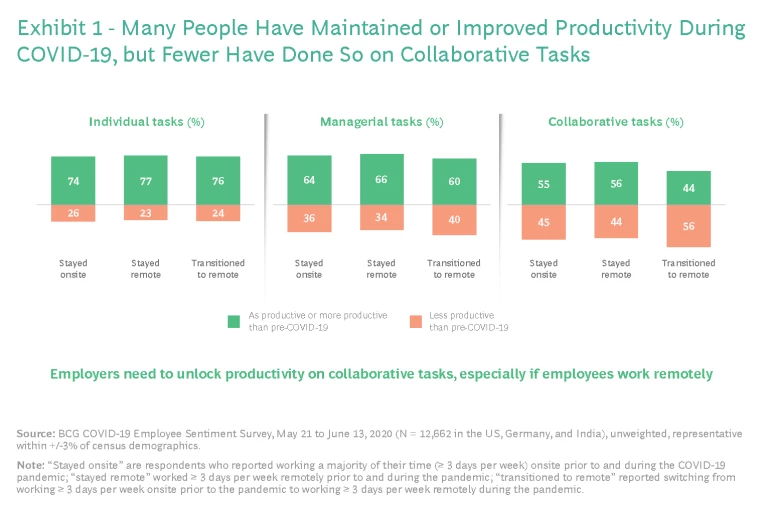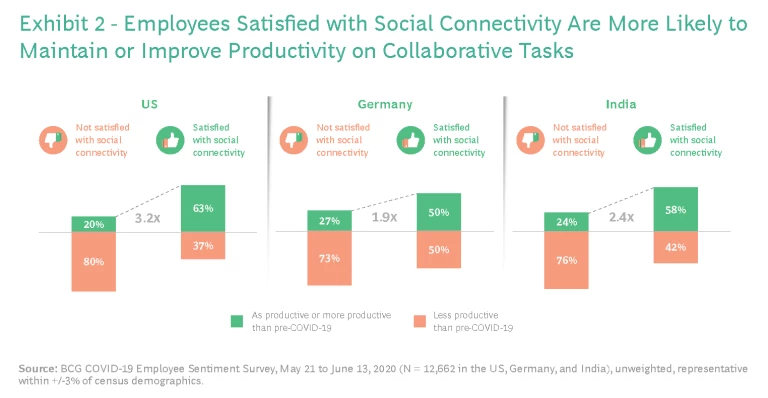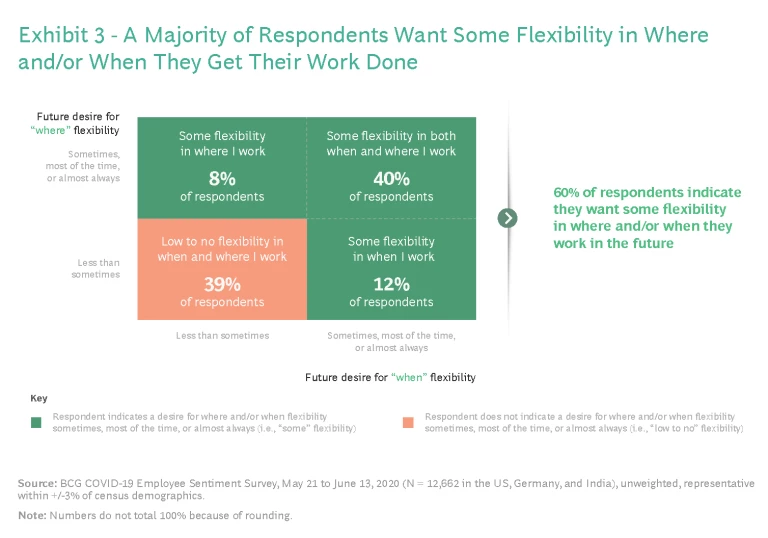Although the COVID-19 pandemic has led to economic, health, and social devastation, it has also created an unprecedented opportunity: to run the world’s biggest-ever workplace experiment. This experience is yielding fascinating insights that have significant implications for the way we should organize work.
To assess employee sentiment on these changes, from the end of May through mid-June we surveyed more than 12,000 professionals employed before and during COVID-19 in the US, Germany, and India. The respondents work in roles such as analysts, engineers, HR personnel, teachers, and health care providers (but generally not in jobs performed onsite such as cashiers or assembly line workers). We explored their attitudes toward flexibility, productivity (on individual, collaborative, and managerial tasks), well-being, career security, social connectivity, culture, learning and development, and the work tools they use.
A surprisingly large number of employees said they have been able to maintain or even improve their productivity during the pandemic.
The responses to the survey yielded unexpected insights. Given the speed and scale of the pandemic-related changes and the fact that employers had no time to prepare staff for the shift to remote work, we expected to see a decline in employee productivity. But while some respondents did report such a drop, a surprisingly large number said they have been able to maintain or even improve their productivity. The responses also reveal a significant shift in employee expectations for the future of work , with a keen appetite for flexible ways of working—and increased openness to this from managers. What’s more, when we analyzed what lay behind the survey results, we uncovered key factors that are critical to maintaining and improving productivity in hybrid remote/onsite and completely remote settings.
It’s now clear that business as usual will be different in the world of work. But if, as our survey suggests, employee productivity is possible at the height of the pandemic with little to no training or preparation, some of the new ways of working could be continued in the post-COVID-19 world. Understanding the drivers of productivity in this new environment and designing appropriate, sustainable working models are crucial to the success of work—both today and tomorrow.
The Productivity Question
It’s hard to overestimate the disruption to work that has taken place over the past several months. Our survey found the pandemic has forced employers to move an unprecedented share of employees—some 40%—to remote working. And for those still onsite, social distancing and collaborating remotely with colleagues have transformed the workplace experience. Remarkably, however, instead of finding a collapse in the functioning of business, our research reveals something few might have predicted: employees perceive that their productivity has predominantly stayed the same or even improved.
While this is a subjective productivity indicator, the data is still striking. Some 75% of employees said that during the first few months of the pandemic they have been able to maintain or improve productivity on their individual tasks (such as analyzing data, writing presentations, and executing administrative tasks). On collaborative tasks (including exchanges with coworkers, working in teams, and interacting with clients), the number is lower. But even so, more than half—51%—of all respondents said they have been able to maintain or improve their productivity on collaborative tasks. What’s more, this applies across geographic areas as well as to both remote employees and those who have remained mostly onsite—indicating that changes to the ways of working are having an impact across the board. (See Exhibit 1.)
To understand why, we dug more deeply into the data. And we focused our analysis on collaborative tasks because, as our survey reveals, in this new remote or hybrid world, collaborative work seems harder and appears to generate the most concern among employers—many of whom assume teams need to meet in person to collaborate. We found four factors that correlate with employee perceptions of their productivity on collaborative tasks, whether working remotely or onsite: social connectivity, mental health, physical health, and workplace tools.
An impressive 79% of respondents who indicated they are satisfied or doing better on all four of these factors said they have been able to maintain or improve productivity on collaborative tasks. In contrast, employee dissatisfaction with a high number of these factors is cause for concern. When we looked at respondents who are dissatisfied or doing worse on at least three factors, only 16% (from a small sample size, with a confidence interval of +/- 3% at 80% confidence) said they have been able to maintain or improve productivity. That’s a difference of almost 400%!
We now walk through each factor in turn.
Social Connectivity. Most surprising in our analysis is the outsize impact that social connectivity has on productivity: employees who reported satisfaction with social connectivity with their colleagues are two to three times more likely to have maintained or improved their productivity on collaborative tasks than those who are dissatisfied with their connections. (See Exhibit 2.) Social connectivity, it turns out, is what enables us to be collaboratively productive. And collaborative productivity is essential for any company looking to improve communication, increase efficiency, accelerate skills acquisition, or harness innovation.
Furthermore, our survey suggests that employees miss the connectivity they had with colleagues in the office. Respondents told us they miss “being able to spontaneously walk to a coworker’s desk and discuss an issue” and “social gatherings at work.” It will be critical for companies to recreate this connectivity regardless of where employees are located.
Mental Health. Similarly, survey responses show a correlation between mental health and productivity: people who have experienced better mental health during the pandemic than before it are about two times more likely to maintain or improve their productivity on collaborative tasks than those who have experienced worse mental health. While awareness of the impact of mental health on work has been increasing, the pandemic—and the stresses and anxieties it has created—underscores how critical it is for employers to recognize the links between mental health and productivity.
Physical Health. For a long time, physical health has been recognized as a driver of productivity, reducing absenteeism and creating a more focused, higher-performing workforce. Our findings provide compelling evidence of this: employees who have experienced better physical health during the pandemic than before it are about twice as likely to have maintained or improved their productivity on collaborative tasks as those with worse physical health. This highlights the importance of building time for sleep, exercise, and nutrition into the new work routines.
Workplace Tools. When we asked respondents about their satisfaction with tools such as videoconferencing, virtual white boards, and project management software, we found another powerful driver of productivity: employees who are satisfied with their tools are about twice as likely to have maintained or improved their productivity on collaborative tasks as those not satisfied with their tools. One tech industry respondent said that “having a desk setup the same as the office and home with the same connectivity” is essential for him in maintaining productivity, while other respondents reported that digital applications and tools such as videoconferencing are important to maintaining their productivity levels.
A New World of Work
Shifts in the way we work are likely to continue as employers move a growing portion of their employees to more flexible models. In fact, BCG’s recent Workplace of the Future employer survey found that companies expect about 40% of their employees to follow a remote-working model in the future.
One financial services company told us it believes a hybrid model (rather than 100% remote) would likely be the working model of choice for many of its employees, who see 100% remote work as unsustainable. The company said that its employees worked an estimated 25% of their time remotely before the pandemic, and it believes that this figure could rise to approximately 50% or more.
Employer expectations are in line with the seismic shift in the way employees are thinking about their workplace. In our research, 60% of employees said they want some flexibility in where and/or when they work. (See Exhibit 3.) This response was most pronounced in the US (67%), while the figure was 50% in India. Combined with our findings on what drives employee productivity, this underscores the fact that listening and responding to what employees want are essential to a company’s success, including its ability to attract and retain talent .
It is encouraging, therefore, that managers appear receptive to flexible models. In our survey, we were struck to find that of respondents who are managers—and some might not expect all managers to welcome increased flexibility—most are in fact very open to this. Over 70% of managers said they are more open to flexible models for their teams than they were before the pandemic.
What This Means for Employers
Our findings suggest that the future of work will be increasingly hybrid. And this presents both challenges and opportunities: to reimagine the entire employee experience and to create conditions that allow employees to thrive in the workplace of the future—one that will be far less office centric. This means developing new hybrid working models that enable employees to move seamlessly between onsite and remote work, as well as thinking about the appropriate physical space—both size and shape—for the hybrid office.
Our findings suggest that the future of work will be increasingly hybrid.
Some challenges are more demanding than others. The good news is that companies have already been investing heavily in the tools needed to work remotely. In our Workplace of the Future survey, 87% of employers said they anticipate prioritizing tech and digital infrastructure investments that support sustained remote work.
When it comes to promoting good employee health, companies need to focus on both physical health and mental well-being. While employees who are no longer commuting have more time to exercise, it is easy for them to be sedentary when working remotely. Meanwhile, with 29% of respondents telling us they have experienced worse overall mental health during COVID-19, it is imperative for employers to create awareness and develop tools and benefits that support employees’ needs. Many companies are experimenting with new approaches, as P&G Indian Subcontinent is doing by inviting employees to webinars with emotional well-being experts, according to a recent report from the Economic Times of India.
Perhaps most challenging, but with the highest payback, will be figuring out how to maximize the social connectivity that takes place in the office. When employees are working remotely, it is hard to replicate the spontaneity of the “water cooler moment” or the camaraderie created by an impromptu lunch, a hallway conversation, or even a fire drill. But even those can be recreated with impromptu calls, whether by phone or FaceTime. And that’s important, not just for employees at home but for those onsite, where social-distancing practices and the fact that many colleagues are accessible only via video will hamper the kind of social connectivity that took place before the pandemic.
It is too soon to provide all the answers. But employers should ask themselves a number of key questions as they work to design customized solutions. In the following sections, we present some of these questions, along with examples of solutions that could spark ideas.
Social Connectivity. Recreating social connectivity in virtual and hybrid settings is tough but essential. And this will be even more critical as companies start to hire new employees who have not built social capital from pre-COVID-19 times.
Some key questions to consider:
- How do you foster a culture in which leaders see it as their responsibility to design and execute social-connectivity strategies and practices for their teams?
- When employees work remotely, how do you replicate the ad hoc, serendipitous encounters with colleagues who work on the same team or were once down the hallway?
- How do you build social capital with new employees who are fully remote?
- How do you maintain team cohesion when some people are working remotely while others are onsite?
- How do you create deep social connectivity in a distanced world where everyone wears a mask, which hides many telling facial expressions?
Early Solutions. As they recognize the power of social connectivity at work, employers are thinking about how to replicate some of the more informal interactions that take place in physical workplaces. We see a number of companies coming up with creative ideas.
Online services company GitLab encourages employees to set aside a few hours per week for virtual coffee breaks and to use Slack for informal connections and conversations. It has also created a “Random Room” on Google Hangouts where anyone can drop in, mimicking unplanned social interactions or water cooler
As described in a recent post from one of our BCG leaders, the serendipity of impromptu hallway or cafeteria-style meetings can be recreated by randomly FaceTiming team members to ask how they are doing.
Companies can also try to make virtual team activities fun. Clevertech, a software company, encourages its employees to play videogames that simulate a collaborative environment and enable complex problems to be solved by the
Mental Health. While companies are increasingly recognizing the importance of this issue, managing employee mental-health challenges—both recognizing problems and addressing them—has never been easy for companies. And when employees are working remotely, it adds to the challenges.
Some key questions to consider:
- What steps should you take to help employees manage the burdens of working remotely, such as the blurring of work-life boundaries and the cognitive overload from being digitally engaged all day?
- What systems and benefits do you need to put in place in order to support employees who are experiencing mental-health difficulties?
Early Solutions. Companies need to find ways of supporting employees’ mental health in the new remote and hybrid workplace. From free therapy sessions to educational efforts, companies are starting to develop solutions to this challenge.
Companies need to find ways of supporting employees’ mental health in the new remote and hybrid workplace.
Front, a workplace-communications platform provider, offers an employee assistance program in the form of a confidential counseling service to help employees with challenges related to work, family, stress, finances, and other personal issues.
According to the Economic Times of India, Microsoft India is bringing in experts to educate leaders and employees on the importance of mental health and well-being during these challenging times.
Employers can also make a therapist available for confidential appointments. In March, for example, Starbucks announced that it would provide all its US-based employees and eligible family members with 20 free therapy sessions a year, according to the Wall Street Journal.
Physical Health. A productive workforce is a healthy workforce. This means promoting positive healthy behaviors in the remote and hybrid workplace.
Some key questions to consider:
- Without being able to provide access to a corporate gym, what other benefits, incentives, and structures might you put in place to encourage physical well-being?
- How do you create team-level work-life balance?
Early Solutions. To encourage employees’ physical health, employers need to create new structures that make it easy for employees to remain fit and well. These can either be offered as benefits or be built into the workday itself.
BCG has created wellness challenges for employees and highlighted winners in the company newsletter. In addition, many BCG offices offer meditation sessions, online fitness classes, and health webinars.
Employers can also consider scheduling regular meetings while out walking in order to build physical fitness into the workday.
To create team-level work-life balance, one approach is to carve out work-free hours every evening or set limits on how early or late work calls can be scheduled.
Workplace Tools. Given the ubiquity of digital technology in the traditional workplace, the virtual or hybrid version needs to replicate this. Employers must use these tools to make it easy for employees not only to carry out their daily tasks but also to collaborate with their teams and other members of the organization—wherever they are located.
Key questions to consider:
- What digital tools do employees need in a non-office-centric workplace—particularly to support collaborative tasks?
- What role does the company play in either providing the physical tools and equipment needed to work from home, such as external monitors and ergonomic chairs, or compensating employees so that they can purchase them?
- When part of the team is in the office and part of it is at home, how do you develop norms to ensure that everyone feels included?
- For those working at home, how do you create the sense of a workplace?
Early Solutions. Some companies were already investing in tools for the virtual workplace before the COVID-19 outbreak. But the pandemic has accelerated the rate at which employers are coming up with ways to ensure that employees have all the equipment they need to work efficiently, even when working remotely.
Cisco got ahead of the game. Even before COVID-19, it routinely invested in setting up its TelePresence system—videoconferencing technology that makes two physically separate rooms resemble a single space—in the homes of its managers and leaders to ensure that they remain productive when working remotely and to facilitate virtual collaboration.
Companies have reacted swiftly to the changes. Initiatives range from helping employees to create comfortable workstations by giving them allowances for the purchase of equipment to delivering technology and office equipment to their homes and subsidizing their broadband costs.
When teams are split between home and office, remote members often feel at a disadvantage during meetings vis-à-vis those who are physically together. To counter this concern and promote equal participation in meetings, one option is to have all participants dial in to the call individually, even if they are onsite.
For each new challenge that arises in the remote and hybrid work world, employers will need to determine the specific tools and techniques that fit into their corporate culture and work patterns. It will be important to understand employee productivity as the workplace continues to evolve. This evolution will increase the need for employers to measure employee productivity in conjunction with employee perceptions. But the key questions and examples featured here provide a starting point for consideration so that companies can enhance productivity whenever and wherever work is happening.
Winners in the New Reality
Powerful forces are driving an increasingly productive workforce for whom traditional boundaries have been eroded and whose physical workplace is shifting beyond recognition. Investments in physical infrastructure, support (such as daycare), and digital technologies will of course be essential. But to benefit fully from the changes, organizations need to focus on helping leaders, managers, and employees to promote physical and mental well-being and—most important—virtual social connections. Given what our data reveals on this, all companies should be urgently investing in building their virtual social-intimacy muscles.
They also need to make transitions between onsite and remote work as smooth as possible, giving employees a cohesive experience that feels designed, not random, and allows them to perform at their best whether onsite or working remotely.
This crisis has presented a once-in-a-lifetime opportunity to reinvent the workplace . Things that might once have seemed impossible have proved surprisingly workable. With collaborative productivity essential to innovation, the changes will enable companies to become more competitive. And given employee desires for flexibility, the changes will also allow companies to recruit and retain the best talent .
Moreover, focusing on well-being and social connectivity will serve another important purpose: helping employees to recover faster from what, for so many people, has been a traumatic, painful, and stressful period. And that is not only good for business—it is good for people.
The authors are grateful to many people who contributed to the research, writing, and production of this report, including Gaby Barrios, Stefanie Beck, Gibson Farone-Collins, Beth Kaufman, Elizabeth Kuriakose, and Krista Ryu.



















